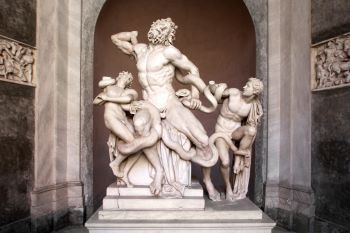






Many different museums belong to the Vatican in Rome. The collection includes classical antiquity, parts of oriental antiquities as well as Etruscan-Italian antiquities and early Christian and medieval art. Works by artists such as Raphael, Da Vinci and Michelangelo can be admired here. The Sistine Chapel and the Raphael Rooms are also part of the Vatican Museums.
Museo Gregoriano Egizio
Founded on the initiative of Pope Gregory XVI in 1839, the Museo Gregoriano Egizio (Egyptian Museum) has nine rooms.
Museo Gregoriano Etrusco
Founded by Pope Gregory XVI, the museum was one of the first to be dedicated specifically to Etruscan antiquity.
Museo Pio Clementino
The original core of the papal collections of classical sculptures goes back to the "Court of Statues" (now Cortile Ottagono) of Pope Julius II (1503-1513).
Museo Chiaramonti
The Museo Chiaramonti contains around one thousand finds of ancient sculptures; it is one of the most extensive collections of Roman portraits and is also rich in examples of idealised sculptures and funerary sculptures.
Galleria Lapidaria
The Lapidarium Gallery – a gallery of stone tablet inscriptions – occupies the southern part of the long corridor that connects the Vatican Palace with the small Belvedere Palace.
Braccio Nuovo
Following the return of the works confiscated by Napoleon, Pope Pius VII (1800-1823) ordered the reorganisation of the papal collections and ordered the construction of a new department for classical sculpture.
Museo Gregoriano Profano
In the Museo Gregoriano Profano you will find the finds of the papal archaeological excavations that have been carried out in Rome and the surrounding area (Cerveteri, Veio, Ostia) in recent decades.
Lapidario Profano ex Lateranense
Only one group of the collected panel inscriptions from the collection of Pope Gregory XVI (1831-1846) is currently accessible to the public, namely the "inscriptions concerning the Roman country towns".
Museo Pio Cristiano
This museum, established in 1854 by Pius IX in the Lateran Palace, was intended to preserve the testimonies of the Christian community of the first centuries.
Lapidario Cristiano
The Lapidario Cristiano collection of more than two thousand inscriptions owes its existence to the archaeologist Giovanni Battista de Rossi (1822-1894).
Lapidario Ebraico
One of the most important Vatican collections of ancient inscriptions is the Lapidario Ebraico.
Pinacoteca
The new Vatican Pinacoteca is secluded and completely surrounded by avenues in a part of the 19th century square garden. Today the collection comprises around 460 paintings.
Ethnological Museum Anima Mundi
The "Vatican World Exhibition" in 1925 was intended to present the cultural, spiritual and artistic traditions of the peoples to the general public.
Carriage museum
The centrepiece of this collection is the magnificent carriage that Leo XII had built in Rome in 1826. The Vatican’s first automobiles are also on display here.
Museo Cristiano
The aim of the museum, which focuses on the exhibition of catacomb artefacts, is to shed light on the treasure of the faith and culture of the Christians of the first centuries.
Museo Profano
The Museo Profano is the first museum collection of secular antiquities and luxury artefacts in the Vatican and of the papal medal collection.
Hall of the Nozze Aldobrandine
The Hall of the Nozze Aldobrandine is also known as the "Hall of Samson" because of the vaulted frescoes by Guido Reni depicting the stories of Samson.
Chapel of St Peter the Martyr
The small chapel of St Peter Martyr at the south-west corner of the tower, which was built in the Vatican palaces between 1566 and 1570, is the middle of the three that Pope St Pius V had built one above the other.
Collection of modern and contemporary art
The collection contains works of art in painting, sculpture and graphic art that have been added to the Vatican collection over the years through donations from artists, collectors and private and public institutions.
Sistine Chapel
Certainly the most famous jewel among the Vatican Museums. The Sistine Chapel takes its name from Pope Sixtus IV Francesco della Rovere (1471-1484), who had the ancient Great Chapel remodelled in the years 1477-1480.
Raphael Rooms
The Raphael Rooms – Raphael‘s four so-called "Stanzas" – were part of the rooms on the second floor of the Vatican Palace, which Julius II (Giuliano della Rovere, 1503-1513) chose as his residence.
Borgia Apartments
The Borgia Apartments comprise six large rooms housing a collection of modern and contemporary art from the Vatican Museums.
Nicolini Chapel
The Nicolini Chapel is just a stone’s throw away from Raphael’s boxes – on the last two floors of the tower.
Chapel of Pope Urban VIII
The chapel was built in 1631, when the papal architects furnished a 5 x 4.40 metre room for liturgical use, fitted it with a lunette-decorated vault and decorated it with gold stuccowork.
Hall of the Immacolata
After the proclamation of the dogma of the Immaculate Conception, this room was designed to commemorate this event.
Hall of the Chiaroscuri
The hall is located in the medieval part of the Apostolic Palace. The gilded boxwood ceiling from the 16th century, based on a design by Raphael, shows the works and coats of arms of Pope Leo X Medici (1513-1521). Raphael also painted the original series of apostles and saints for Pope Leo X in 1517-1518.

Clickhere
to see on google maps
Address: Viale Vaticano 00165 Rome Italy